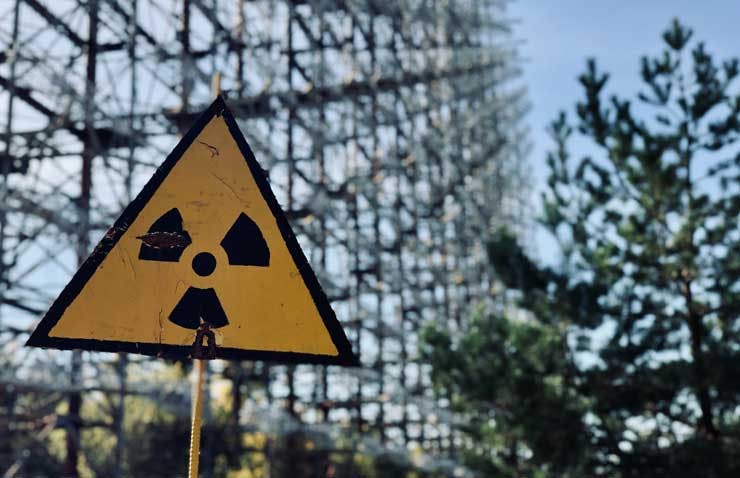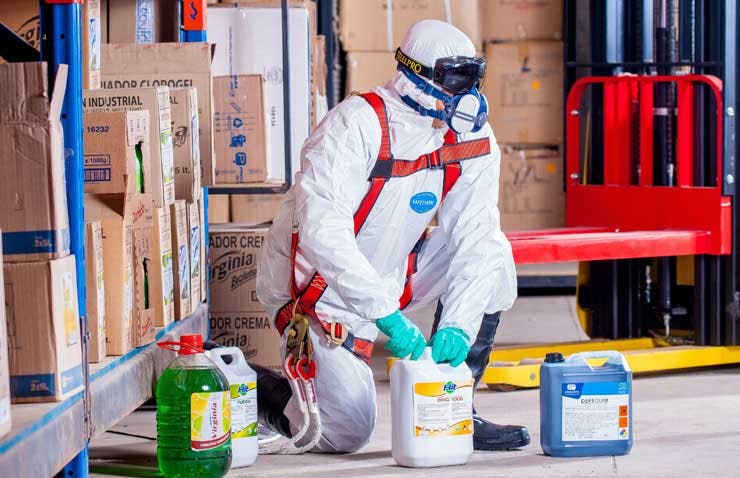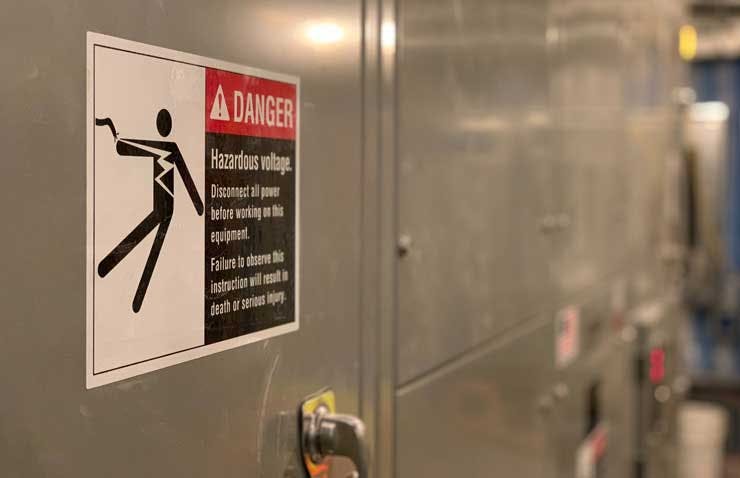10 Hazard Communication Training Courses
We’ve compiled a list of ten hazard communication training courses covering specialized topics like Globally Harmonized System standards, OSHA hazard communication standards, chemical hazards, and personal protection methods. These courses are designed to help workers ensure safe operations while working in high-risk industries like construction, manufacturing, healthcare, and many others.
Last published: 7th January 2025

1. Hazard Communication
SC Training (formerly EdApp)’s Hazard Communication course is designed to give your workers a basic overview of chemical hazards, communication procedures, and other safety information. Through this microlearning course, your workers can easily learn about the different chemicals that present physical hazards and pose environmental risks. Its bite-sized lessons walk them through the hazard signs they’ll need to know in order to safely handle chemicals in the workplace. The course also lists down the different responsibilities of chemical manufacturers, which primarily include inspecting chemical labels and developing written hazard communication programs.
With SC Training (formerly EdApp)’s user-friendly creator tool, you can import this course directly from the course library and edit its content according to your team’s training needs. It can be accessed via desktop or mobile devices and is made available in 16 different languages including English, Spanish, Japanese, Arabic, and French.
- Price: Free (up to 10 users)
- Length: 5 to 10 minutes per lesson
- Certification: Available
Created By SC Training (formerly EdApp)
Explore this free course
2. Globally Harmonized System (GHS)
GHS, which stands for the “Globally Harmonized System of Classification and Labeling of Chemicals”, is a system that defines and classifies chemical hazards and communicates safety precautions through labels and Safety Data Sheets (SDS). This system was developed by experts from the United Nations to standardize hazard classifications and chemical handling processes all over the world. SC Training (formerly EdApp)’s Globally Harmonized System (GHS) course delves into a quick background of the GHS label, hazard classification, hazard communication, and proper GHS application and implementation. As your workers go through the lessons, they’ll also be able to learn about the proper steps in classifying potential hazards and understand the differences between chemical substances, mixtures, and alloys.
Feel free to import this hazard communication training course from SC Training (formerly EdApp)’s course library. Even without design experience, you can easily edit its content, incorporate games, add interactive elements, or rebrand the entire course in line with your company’s guidelines.
- Price: Free (up to 10 users)
- Length: 5 to 10 minutes per lesson
- Certification: Available
Created by SC Training (formerly EdApp)
Explore the course
3. Hazard Communication Awareness
Hazard Communication Awareness is an employee training course by BIS Safety Software that focuses on bringing awareness about the dangers of chemical exposure and communicating GHS and OSHA hazard communication standards to protect workers from these risks. This online course helps workers learn how to determine hazards, how to use safety data sheets, MSDS, and how to add labels and warning signs. Your workers can also expect a quick overview of potential physical hazards and long-term health effects of chemical exposure, including organ damage, reproductive problems, weakened immune system, asthma, and even cancer. At the end of the course, your employees can take an assessment and if they achieve a passing mark of 80% or higher, they’ll be able to download and print their certificate of completion.
- Price: $69.95 USD
- Length: 1 hour
- Certification: Available
Created by BIS Safety Software
Explore the course
4. GHS and OSHA Hazardous Communication
Designed by 360training, the GHS and OSHA Hazardous Communication course contains general information about hazard communication training standards and chemical safety hazard prevention methods used by workers in the construction, automotive, manufacturing, pharmaceutical, and healthcare industries. Some of the topics covered in this 1-hour online course include the Globally Harmonized System, hazardous materials, labels, safety data sheets, hazard controls, and HAZCOM terminology. While this hazmat training course isn’t free, it’s been created specifically for easy self-paced learning. You can also look forward to other perks like being able to save progress as you go and 24/7 access to 360training’s customer support.
- Price: $20 USD
- Length: 1 hour
- Certification: Available
Created by 360training
Explore the course
5. GHS and Hazard Communication Online Course
OSHA requires all employees exposed to chemical hazards to be properly informed on potential risks as well as safety and health protocols. With OSHA Education Center’s GHS and Hazard Communication Online Course, you can provide your workers with relevant hazard communication for managers and supervisors and site safety training. The lessons tackle topics such as basic OSHA requirements for hazard communication, GHS labeling requirements, GHS pictograms, and hazardous chemical inventories, all needed to comply with regulatory standards. A huge advantage of this training course is that your workers can email an OSHA Education Center course trainer anytime for questions or concerns. But do note that once learners begin their online training, they’ll have a limit of 180 days to complete the entire course.
- Price: $24.95 USD
- Length: 1 hour
- Certification: Available
Created by OSHA Education Center
Explore the courseExplore our library including hazard communication training courses.

6. Hazard Communication by eSafety
Divided into two parts, the online Hazard Communication training course by eSafety dives into how hazard communication works, its regulatory systems, and its alignment with the GHS. It’s also been recently updated to include the regulation changes that OSHA put in place in 2012, which can be found in the OSHA standard 1910.1200. Through this comprehensive course, you’ll learn about specific topics like combustible materials and explosion hazards, corrosive substances, toxicological information, protective equipment, fire-fighting measures, and first-aid measures. Overall, the lessons aim to increase your knowledge regarding chemical hazards, classification systems, and basic protection methods to ensure the safe handling of chemicals.
- Price: Get a quote
- Length: 50 minutes
- Certification: Available
Created by eSafety
Explore the course
7. OSHA Hazard Communication and GHS Training
Hazmat School designed the OSHA Hazard Communication and GHS hazardous communication training course to help you train your workers on how to handle hazardous materials, which can include but are not limited to toxic substances, solvents, cleaners, corrosive chemicals, caustic chemicals, flammable liquids. This course gives learners a complete overview of chemical classifications and label systems. It also goes into detail about the steps needed to create an effective safety program involving hazardous material storage and handling as well as proper cleaning. There are no prerequisites needed for this workplace safety training course but learners do need to take a final assessment to avail certification.
- Price: $35 USD
- Length: 2 hours
- Certification: Available
Created by Hazmat School
Explore the course
8. Hazard Communication by Lion Technology
With the help of Lion Technology’s Hazard Communication hazard communication awareness course, you can help your workers gain an awareness of chemical hazards and understand the importance of preventing hazardous chemical exposure. This course delves into specialized topics like GHS hazard labels, pictograms, and safety data sheets that your workers will need to communicate crucial hazard information. It also discusses safety training requirements needed for working in environments with exposure to chemicals and the effects of long term chemical toxicity. Overall, Lion Technology’s team of experts and safety trainers have created these comprehensive and well-designed lessons to help teams comply with OSHA HAZCOM standards. The online learning management system allows your workers to go through the course at their own pace and resume training from where they left off with the automatic bookmarking feature.
- Price: $49 USD
- Length: 2 to 3 hours
- Certification: Available
Created by Lion Technology
Explore the course
9. Hazard Communication for Managers and Supervisors
Hazard Communication for Managers and Supervisors by ClickSafety is a specialized training course designed for operation managers, project owners, building and facility owners, and distribution and supply managers who work with hazardous chemicals. Through this course, senior managers can meet their training requirements for hazard communication. They’ll also learn how to develop communication plans, create compliance checklists, label inventory, and detect and control hazardous chemicals. Some of the lessons also cover specific industry terms like safety data sheet properties, precautionary statements, pictograms, and signal words among others. Similar to the courses mentioned above, ClickSafety also provides learners who pass their final assessments with a completion certificate.
- Price: $45 USD
- Length: 1 hour and 5 minutes
- Certification: Available
Created by ClickSafety
Explore the course
10. Controlling Hazardous Energy: Lockout/Tagout
Targeted specifically for plant workers, SC Training (formerly EdApp)’s Controlling Hazardous Energy: Lockout/Tagout course gives them a broader look at the different types of hazardous energy, including chemical, thermal, pneumatic, hydraulic, mechanical, and electrical hazards. It then walks them through the lock-out procedures that must be implemented in the event of an emergency. Through the Tagout lesson, your workers can learn about the proper labeling systems and warning signs used to tag worksites and specific equipment when they are unsafe for operation. Overall, this course highlights the importance of using proper visual danger signs to prevent potential accidents in the workplace. You can access this 3-part course directly from SC Training (formerly EdApp)’s course library and deploy it to your workers in just a few easy steps.
- Price: Free (up to 10 users)
- Length: 5 to 10 minutes per lesson
- Certification: Available
Created by SC Training (formerly EdApp)
Explore the courseUnderstanding safety protocols with hazard communication training
When employees work with chemicals, they face numerous risks that can range from potential health hazards to more specific physical hazards caused by corrosive chemicals and flammable gas. As an employer, you must provide your workers with proper hazard communication training during onboarding and whenever a new chemical is introduced into the workplace. It’s also important to note that organizations found to be non-compliant with OSHA’s standards can face severe fines for endangering the lives of employees. Through hazard communication training, your team will be able to understand specific topics like labeling systems and safety data sheets that they’ll need to comply with OSHA HAZCOM standards. It also allows them to learn more about the risks that may occur due to unprotected exposure to chemicals and the measures that they must take to protect themselves from these hazards. To help you train your team, we’ve put together a list of the most comprehensive and up-to-date hazard communication training courses.